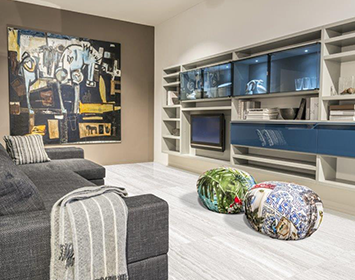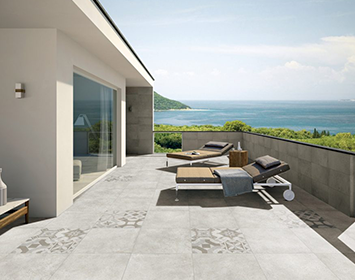Thanks to their reputation as being one of the most durable, dust adverse and easy to maintain materials, tiles have long been a popular go-to for both residential and commercial spaces, particularly for wet areas. Significant developments in technology also means that tiles have never been more versatile, and the sheer amount of choice that shoppers have cannot be understated.
As a construction material, tiles tick all of the right boxes: durability, toughness, practicality and waterproof characteristics – but, they’re also incredibly versatile. With a plethora of colours, finishes, shapes, patterns, designs and sizes to choose from – there’s a tile for just about every occasion.
Nine Steps For Choosing The Right Tile
Thanks to ever-evolving designs, these highly functional and decorative materials have stepped out from being background noise in a bathroom or kitchen space, and into the spotlight both inside the home and out. Whether you’re looking for tile designs that invoke warmth, luxury or even just practicality, both builders and DIY renovators opt to use tiles in a wide variety of environments.
While opting for ceramic and porcelain is often the most popular choice for standard indoor renovations, many people don’t realise just how many different materials tiles are available in, such as glass, cement, metal and stone – so what’s involved when it comes to choosing the right type of tile?
Consider The Area – What constitutes as the perfect tiles for the floor is going to differ greatly when compared to the most suitable options for a splashback, so make sure you carefully consider the needs and requirements of what the area of your kitchen, bathroom, laundry or even outdoor area needs before selecting the one that seems ‘best’ on face value.
Select Your Material – For wet areas, tile materials can include a variety of natural stone, ceramic, porcelain and glass. Applications like timber, vinyl plank, vinyl hybrid and laminate board tiles are most commonly used in flooring, while natural stone, ceramic, and porcelain tiles can be used for all your wall and flooring projects. In comparison, glass tiles are commonly reserved for walls and splashbacks.
Make A Budget – Before you get too carried away with the aesthetics of your new tiles, be realistic and do your homework as to how much they actually cost. Thanks to significant advances in technology, there are many ‘lookalike’ replicas that can be almost as good as the high end materials, so consult with the professionals if you get stuck on pricing options.
Think Of Your Lifestyle – Do you share your home with children or pets, or perhaps have a lot of traffic in and out of your kitchen? This is also a key influence when it comes to determining the right tiles, as it can also dictate the level of durability that you need, along with how much ongoing maintenance you’re willing to commit to.
Choose A Pattern – The beauty of most tile shapes is that there is a plethora of patterns available that can drastically alter the look and feel of the end result. From herringbone to running bond brick, choosing a tile layout is an important factor that deserves your consideration prior to settling on a winner, as it can drastically change the end result.
Select A Finish – Tile series generally come in three types of finishes – matt, lappato and grip. Each tile finish offers its own set of benefits and drawbacks, so it’s crucial to understand the differences before settling on a selection. If you aren’t sure on what practical aspects your space needs in a tile, don’t be afraid to ask for some assistance from the professionals.
Textured vs Flat – Manufacturers typically raise the texture of tiles to give them non-slip properties, making them an ideal choice for bathrooms and kitchens. Another benefit of textured tiles is that they can make your room look bigger, although this all depends on the room. Textured tiles are also a great way to change up your look without committing to bold colours.
The Room Size – As a general rule, tiles are quoted based on how many of them you will need to fill the space. Naturally, the bigger your room, the more tiles you will need, so this can also greatly influence the final cost. In a smaller area, opt for lightly coloured tiles, as this can go a long way when it comes to making the room feel bigger.
Don’t Forget The Grout – Ensure that you don’t underestimate the visual impact of choosing a grout colour that contrasts beautifully with your tile. If you get it wrong, all your hard work in selecting the right tile can easily fall flat. Although seemingly minor, your grout can make or break your tile material, so don’t be afraid to ask the professionals before you commit.
Ultimately, it can be overwhelming to choose between the many options available for buyers when it comes to sourcing the perfect tile. However, it’s important to remember that you don’t need to wing it or go it alone, as accessing help or even friendly, honest advice might just be easier than you think.
Talk To The Experts On Tiles
While your options for tile finishes are almost limitless, selecting the right type of product for your home certainly isn’t an easy feat. With each space, comes a different preference or priority: are you chasing style, functionality, or simply want to stay within the budget?
In operation for over 24 years, at Tile Wizards we pride ourselves on getting you more – for less. We pioneered the warehouse format, and our stores are purposefully designed to make your selection easier, and ultimately offer our customers quality, price and the right advice.
Even if you are just after some honest and friendly advice – please don’t hesitate to get in touch with us at Tile Wizards today for a free quote. We’re able to work with you in order to bring your dream flooring solution to life.









